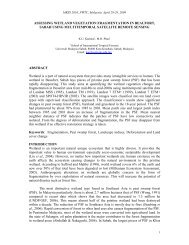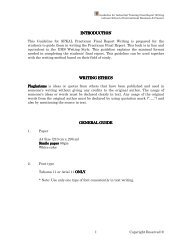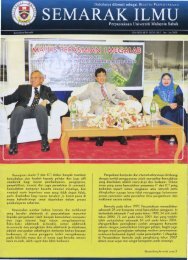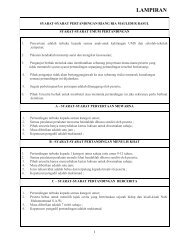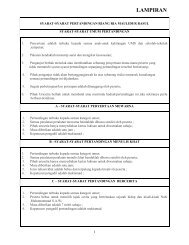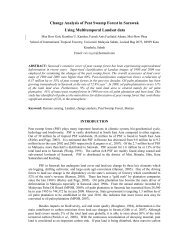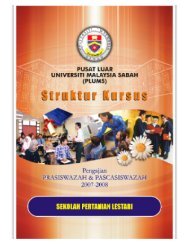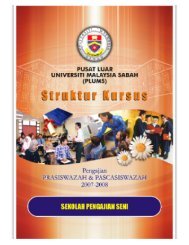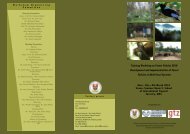Report for the German Agency for Technical Cooperation (GTZ) - UMS
Report for the German Agency for Technical Cooperation (GTZ) - UMS
Report for the German Agency for Technical Cooperation (GTZ) - UMS
Create successful ePaper yourself
Turn your PDF publications into a flip-book with our unique Google optimized e-Paper software.
Bernaulus Saragih<br />
REDD in East Kalimantan, <strong>the</strong> economic challenge: Potential and opportunity, who will pay<br />
<strong>the</strong> cost?<br />
Research rational and objective (in Brief)<br />
Bali conference on climate change (COP 13) in December 2007 has issued many<br />
international agreements on combating climate change and one of <strong>the</strong>m is <strong>the</strong> reduction of<br />
<strong>the</strong> carbon emission from de<strong>for</strong>estation and degradation.<br />
Indonesia as a host of <strong>the</strong> conference wants to implement REDD policy following <strong>the</strong><br />
potential of reduction of <strong>the</strong> emission that could be released as an aim of preventing <strong>for</strong>est<br />
from destruction and developing <strong>the</strong> economy of <strong>the</strong> <strong>for</strong>est dependent community.<br />
Many seminars and meetings have been made following <strong>the</strong> high interest of local<br />
government and <strong>for</strong>est stakeholders in East Kalimantan on <strong>the</strong> REDD program. But, <strong>the</strong>se<br />
seminars could not determine what is <strong>the</strong> potential cost and benefit that could be gained and<br />
paid by <strong>the</strong> <strong>for</strong>est management. Who will pay <strong>the</strong> cost of being involved in REDD scheme,<br />
where <strong>the</strong> benefit is coming from, will <strong>the</strong> benefit from REDD can compensate <strong>the</strong> lost of<br />
opportunity to gain benefit from timber?<br />
This research is made as an ef<strong>for</strong>t to get <strong>the</strong> answer of <strong>the</strong>se questions, and based on this<br />
answer fur<strong>the</strong>r decision can be made whe<strong>the</strong>r <strong>for</strong>est manager, policy makers, and local<br />
government will be interested in <strong>the</strong> implementation of RED<br />
Research site and duration:<br />
Research area is East Kalimantan, <strong>the</strong> research will be conducted <strong>for</strong> 3 years of 2009-2011.<br />
Research will be conducted in some steps,<br />
STEP ONE.<br />
The research will be started with <strong>the</strong> determination of <strong>the</strong> potential cost dealing with <strong>the</strong><br />
process of being involved in REDD.program. Cost items will be listed consist of what is <strong>the</strong><br />
cost and how much? How <strong>the</strong> cost will be paid? And what is <strong>the</strong> source of cost?<br />
next step is to determine <strong>the</strong> potential market and <strong>for</strong>eign buyers of <strong>the</strong> emission. What is <strong>the</strong><br />
process and how <strong>the</strong> agreement will be made and what is <strong>the</strong> benefit<br />
<strong>the</strong>n assessing <strong>the</strong> value of <strong>for</strong>est <strong>for</strong> <strong>the</strong> local people based on <strong>the</strong> local economic and<br />
perspectives and valuate <strong>the</strong>m in currency (Rupiah or Dollar). Valuation will be made on<br />
hectare base. For this purpose <strong>the</strong> pilot research area will be selected on <strong>the</strong> basis of<br />
community level<br />
Results of step one is<br />
The comparison of current <strong>for</strong>est economic value of gained by local community with <strong>the</strong><br />
potential benefit gained from <strong>the</strong> REDD program.<br />
Output of step one<br />
The willingness of local community to be part of <strong>the</strong> REDD program is identified<br />
STEP TWO<br />
Determine <strong>the</strong> benefit and cost of <strong>for</strong>est conservation and conversion <strong>for</strong> palm oil plantation.<br />
Assess <strong>the</strong> cost of conservation and <strong>the</strong> benefit that could be gained from REDD. Assess <strong>the</strong><br />
cost of conversion and <strong>the</strong> benefit that could be gained from palm oil plantation. Preparing<br />
two plot experiments one in proposed or conservation or <strong>for</strong>est protection, and <strong>the</strong> o<strong>the</strong>r one<br />
is in <strong>the</strong> proposed conversion <strong>for</strong>est area <strong>for</strong> palm oil plantation<br />
Result of step two<br />
Return to investment of REDD PROGRAM compare with PALM OIL PLANTATION <strong>the</strong><br />
comparison of Nett present value (NPV), Internal rate of return (IRR), and <strong>the</strong> benefit cost<br />
ratio (BCR) of REDD implementation and Palm oil plantation<br />
49



